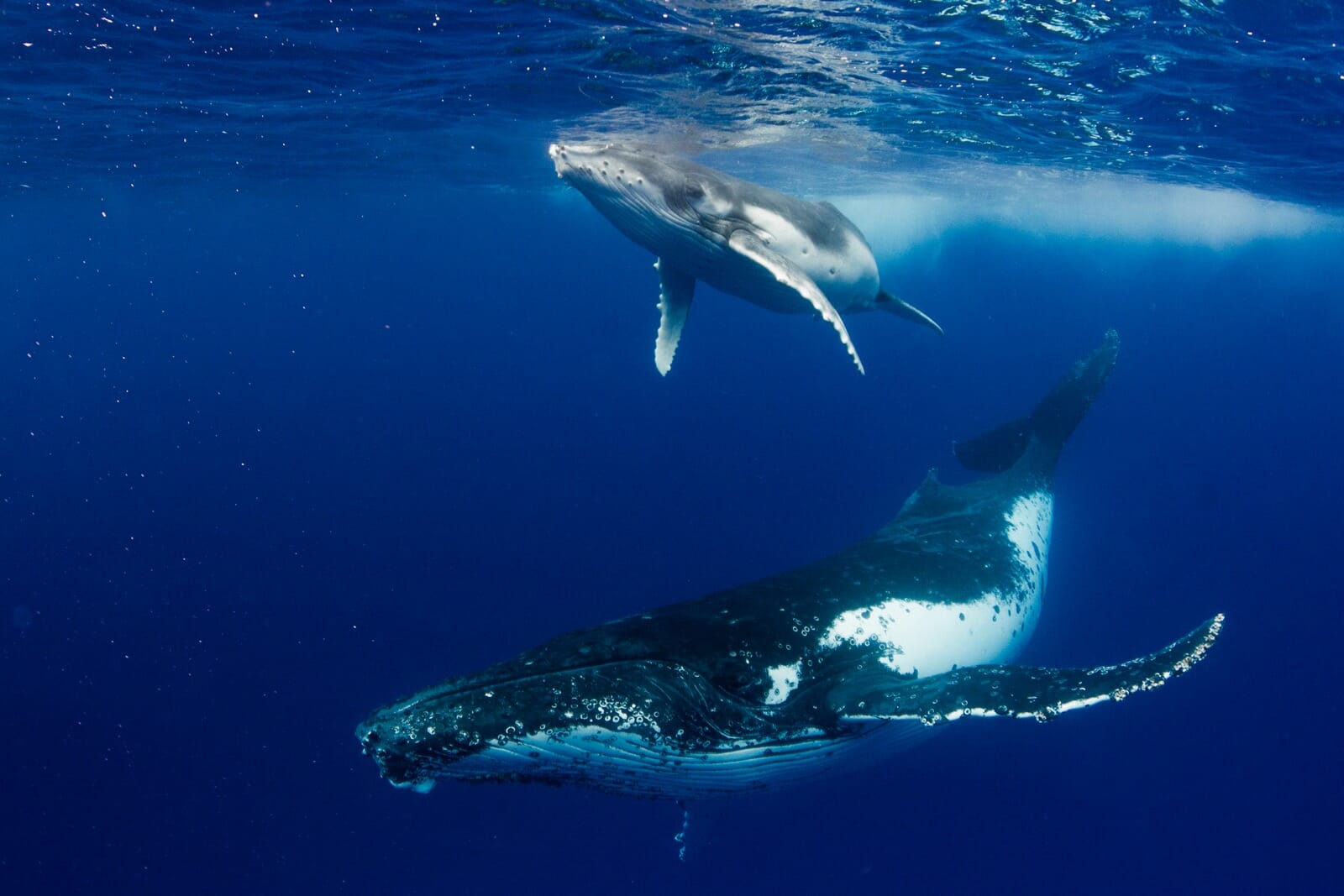Whales and Wanderlust
Coastbeat chats to Forster’s Gabby Hunter who’s never happier than when she’s on or in the water. Gabby also shares with us her favourite wildlife encounters around the world.
She may be a qualified Speech Pathologist and hasn’t dismissed the idea of returning to uni to study medicine, but Gabby Hunter is perfectly content working in the family business – Dive Forster at Fisherman’s Wharf. What’s more, in addition to exploring local waterways, work allows her to venture further afield and experience all that Planet Ocean has to offer.
It makes perfect sense that Gabby’s so passionate about the ocean and its creatures – after all, she’s the product of a romance that blossomed some 30 years ago when her mum came to do a dive course at her father’s dive centre. And Gabby’s been diving into the deep as long as she can remember; first as a swimmer and snorkeler and now as a trained PADI Rescue Diver.
So, what is the great appeal of the ocean for Gabby? “I feel more at home swimming than I do when I’m on land. I feel completely at peace in the ocean, especially when I dive as there is a beautiful sense of weightlessness.”
As wonderful as she feels beneath the surface, Gabby’s got it covered above it too. She is a Grade 1 Coxswain (also known as a Commercial Vessel Master) and, as far as she’s aware, the only female of the 20 or so qualified coxswains in the region. “I’m very proud of what I do and am used to raised eyebrows when I introduce myself as the ship’s captain. I also know that the guys at Bunnings mean well when they ask if I need help tying a certain knot.” Needless to say, afters years and years on boats, Gabby’s got knot-tying all sorted.

A typical morning in summer (overseas trips are scheduled during our winter months) might involve taking guests to swim with dolphins followed by a dive charter. Gabby says that every dive is a new experience. “Just yesterday, I had the most spectacular dive with about 25-30 grey nurse sharks surrounding me.”
For Gabby, the Great Lakes region presents the best of both worlds. “We’re so lucky here. Beyond the beautiful coastal areas where you’ll find some of the best beaches I’ve ever seen, there is the gorgeous hinterland region which has unbelievable waterfalls, stunning rural properties and excellent vistas, especially up in the Manning.”
Although Gabby says Forster is home and always will be, foreign exploration beckons (especially when it involves getting wet) and with that in mind, here are Gabby’s suggestions for those experiences we should all try before we kick the bucket.
And, her key selection criteria? “It may be ridiculously corny, but I kept thinking of that quote, ‘life is not measured by the number of breaths we take but by the moments that take our breath away.’”
- Humpback Whales – Tonga
Humpbacks can be seen in many spots around the globe, but you can only swim with them in a few locations worldwide. And I believe Tonga to be the pick of the bunch.
These beautiful creatures have given me, hands down, the best interaction I have experienced with a wild animal, ever.

Female humpbacks grow up to 18 metres long and can weigh up to 40 tonnes. To have a creature the size of a school bus slowly approach you with her brand new, two-week-old calf perched on her nose is humbling, to say the least.
I’m blessed to have travelled to Vava’u, Tonga to swim with these incredible mammals several times. I still vividly recall my first trip at the age of 16. The whales were so aware and careful of us in the water. The calf gently swam around our group, making eye contact with us and mimicking our movements and all the while her mum slept peacefully below us. The calf would occasionally swim back to mum for a drink of milk and to rub her soft belly over mum’s nose. It reminded me of when we kiss our own mum on the cheek.
- Africa – The Big Five
The Big Five are found in Sub-Saharan Africa including, but not limited to, Botswana, South Africa, Zimbabwe and Zambia.
No animal list would be complete without the ‘Big Five’ in Africa. My dad, Ron Hunter, has been travelling to Africa with groups for 10 years or so now. Next May, I will venture to the Eastern Cape of South Africa to see the ‘Big Five’; African Elephant, Black Rhinoceros, Cape Buffalo, African Lion and the elusive, African Leopard.
- The Whale Sharks of Cenderawasih Bay
Cenderawasih Bay is in one of the most remote areas of Indonesia. This bay is to the north of the mainland of West Papua (where Papua New Guinea meets Indonesia). Access is difficult and only a couple of Liveaboard Dive Boats travel to the area. It is a special charter to a place where you’re unlikely to see another boat for miles, besides those of traditional Papuan fishermen.
There are around 30 whale sharks in the bay who cluster around traditional Papuan fishing platforms anchored to the seabed. The whale sharks gather around the platforms in the hope for scraps and small fish – it’s an ‘all you can eat’ buffet for them. The visibility is unbelievable, and, in my opinion, this unique experience offers the best whale shark encounter anywhere on Planet Ocean.
- The East Coast of Australia – Our beloved Grey Nurse Shark
I was six years old when I first saw these sharks whilst snorkelling at Latitude Rock, off the Cape Hawke Headland (just south of Forster). I feel blessed to dive with them regularly.
They’re critically endangered and despite their fierce appearance, are placid and non-threatening – except to fish of course! They aggregate at the same spots in the ocean so they’re a very reliable shark to dive with. They cruise up and down the sea floor scratching their bellies and flirting with each other all day. And at dawn and dusk, they feed on small baitfish and other snack-sized sea critters.

It’s both exhilarating and mesmerizing to dive with these sharks – you end up transfixed and in awe as they swim calmly by you. Plus, they aggregate all up and down our coast. Forster has a year-round population.
- Giant Pacific Manta Rays – The Maldives, Thailand and Revillagigedo Archipelago
Think of a giant eagle crossed with a whale and mixed with a wide-mouthed shark. That’s a Manta Ray. They have a long tail that looks very similar to a sting ray, but it isn’t barbed and can’t sting. Their wingspan, edge to edge, can get up to five metres and they can weigh up to 1.5 tonnes.
Manta rays are filter feeders – they use their strangely shaped mouths to scoop plankton up. They’re one of the most inquisitive animals I’ve come across.
I first saw one of these majestic gentle animals in The Maldives and was lucky enough to see several during a dive in Thailand earlier this year. In November, I will travel to Mexico’s Revillagigedo Archipelago to dive with them again.
- Sea Lions – The Sea of Cortez, Mexico
Sea lions are like the puppy dogs of the sea – playful, cheeky and sometimes, up to no good. The sea lions of Mexico will play shell games with you. Pick up a light-coloured shell and toss it away from you while SCUBA diving and the sea lion will pick it up and bring it right back. It must be seen to be believed!

There are so many places to visit for incredible wildlife encounters which makes narrowing it down almost impossible. Other amazing wildlife experiences I would recommend are the Great White Sharks in Guadalupe, Mexico. It’s cage diving just below the surface and offers such a unique opportunity to view the ocean’s apex predator.
Polar Bears and the Northern Lights in the Arctic is another important one for the list and in the next few years I plan on a sailing expedition to experience this. At the end of the voyage, I will free dive between the tectonic plates of Europe and America.
Gabby works for Dive Forster at Fisherman’s Wharf and Quest Tours.
Quest Tours conduct many of the wildlife experiences detailed above


